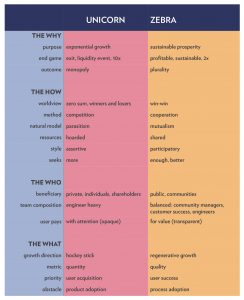Debunking the Biggest Funding Myth with Zebras Unite
Illustration by Arthur Jones, courtesy of Zebras Unite
Jennifer Brandel and Mara Zepeda existed in financial purgatory. They’d built mission-driven, for-profit companies that didn’t fit social investment portfolios or venture capitalist criteria. “We'd created tech-enabled companies with purpose, and then discovered this type of company is basically unfundable,” Brandel said. They got frustrated, but they didn’t go bankrupt. They organized. Together, with entrepreneurs facing the same problem, they founded Zebras Unite, a collective working to develop financing alternatives for companies that don’t fit the standard capital model.
Brandel, CEO and co-founder of Hearken, and Zepeda, CEO and co-founder of Switchboard, visited Albuquerque in November to hold a workshop on new approaches to business funding. In our interview, they argued that our city has the resources entrepreneurs need, we just need to dismantle the systems that limit access. City Alive leaders and community partners have been working to solve these problems over the last few years; Brandel and Zepeda had interesting perspectives to share about Albuquerque’s unique challenges and progress. Here’s what they had to say:
You work to increase access to capital for “zebra” companies. What makes a company a “zebra”?
[Brandel] When this movement started, the companies we were building didn’t fit the model that venture capital and angel investors usually fund. We weren’t looking to be a “unicorn”—a one-in-a-million “disrupter” company that promises ten times return on investment. And we didn’t fit the nonprofit model either. As we kept asking why, it became clear that there's a lag. The current capital system doesn’t fit the creativity of future companies that focus on repairing society—rather than breaking or disrupting it.
Zebra companies are both black and white: they are profitable and improve society. They won’t sacrifice one for the other. Zebras survive through cooperation. By being in a herd, they evade their predators, move and work together. We saw that there were so many startups out there struggling with the same capital access problem—many of them women and minority-owned—so we’re bringing them together through Zebras Unite.
[infographic courtesy of Zebras Unite source]
What kinds of barriers did you face as entrepreneurs?
[Brandel] Mara and I can never get bank loans. Our companies are in new, high-growth and tech-focused markets. We don’t have collateral, all we have are our laptops. We don’t have connections with friends and family with lots of money. As we were building these hybrid consulting and technology companies, we realized that was kryptonite to venture capitalists. They’d argue, “You’re either software or services, not both.” But that’s a false dichotomy. We can be both—or something completely new! But when you don’t fit a pattern the status quo will recognize, you get completely locked out.
What’s the biggest myth about capital?
[Zepeda] There’s not a scarcity of capital. Which is hard for entrepreneurs to believe. But in New Mexico, for example, the state investment council oversees $24 billion in capital—and much of those funds are going out of state. Systems change requires that entrepreneurs be entrepreneurial about the economic systems they’re operating in.
We need to start asking questions about where the City and state budgets, public employee pension funds, commercial loans and college and university endowments are invested. How is that board member appointed? How can I get on that council? Where does the money come from? Then we can reroute more of the money toward businesses that are being left out. This is not zero sum game where everyone's competing for the same money. There is enough money out there, and we need to be asking, “Where is it, what is it, and how can it be more equitably distributed to benefit our local economy?”
What is the Zebras Unite approach?
[Zepeda] The method is to find the biggest pots of taxpayer or public employee money—City budget, the pension system—then piece it apart. If we’re trying to find new approaches to capital, we can’t rely on philanthropy and charitable contributions. You can’t bake sale your way to closing the generational wealth gap. Jenn and I have backgrounds in journalism, so we are comfortable doing this kind of research. But if we want real, fundamental policy change, all citizens and business owners need to adopt an investigative journalist lens and scrutinize budgets. That money is coming from your pensions, unemployment insurance, tax dollars, student loans—it is your money! Follow that money back. Then lobby your elected officials, join the councils and redirect where it’s going.
How do you measure success?
[Brandel] In long-term systems change projects like this, you’ve got to be patient. Charlie Baum, the founder of Starting Point, has a great concept for measuring this. He says there are four types of wins: insight, process, capability and outcome. The knowledge, insights and capacity you build during the learning process are just as much of a win as the outcome itself. You’ve got to track the stuff on the way that manifests and changes the community at large.
[Zepeda] Exactly. For a grandmother who went from only making her cookie recipe for her family, to starting a food business and selling to 10 people, that’s enough. That’s a win. At the workshop we took 30 entrepreneurs in Albuquerque who had never seen the city budget to downloading that PDF and analysing where the money goes. That’s step one and that’s a win. Massive systems change and city budget revision is step 25. We all have to start somewhere. When it comes to economic development, that starts by asking a lot of very basic questions.
How do we start breaking down the barriers?
[Zepeda] I love that in Albuquerque you’re starting by listening to the founders and owners. You’re asking them, “What are you looking for?” That’s so important. As new patterns emerge, we’re not trying to create one-size-fits-all solution, we need to create smart experiments and share the findings with each other. The Co-op Capital project is an excellent example. We need experiments that take into account the soil of the community we’re on and what’s prime to grow there.
Thinking ecosystem-wide means not just asking, “How does my business survive?” but also, “How do I lift up everything around me?” The example you used about La Montanita Co-op giving a Co-op Capital loan to Windmill Dairy is the perfect example of this. Helping the dairy means La Montanita can meet its mission better: they have more fresh, local products to offer. That model is so exciting. We’re interested to see how that evolves, and hope you’ll share what you learn with the Zebra community.
To learn more about Zebras Unite, visit zebrasunite.com, and join the online community at zebrasunite.mn.co (they are currently looking for Albuquerque chapter chairs).
Connect the Dots:
City Alive is a city-wide initiative working to create more equitable capital systems in support of Albuquerque’s minority entrepreneurs. Read more about the Co-op Capital program and our work in racial equity.


